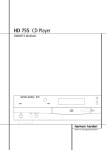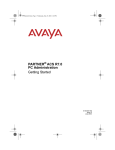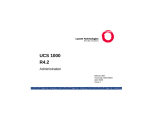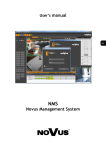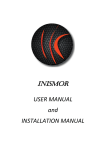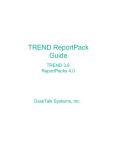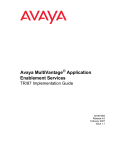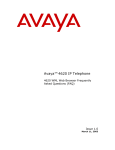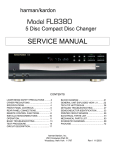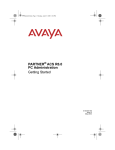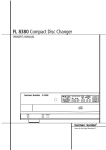Download Troubleshooting
Transcript
Avaya™ Interactive Response Release 1.2.1 Troubleshooting Issue 1.0 Publication Date: June 2004 © 2004, Avaya Inc. All Rights Reserved Notice Every effort was made to ensure that the information in this document was complete and accurate at the time of printing. However, information is subject to change. Preventing Toll Fraud “Toll fraud” is the unauthorized use of your telecommunications system by an unauthorized party (for example, a person who is not a corporate employee, agent, subcontractor, or working on your company's behalf). Be aware that there may be a risk of toll fraud associated with your system and that, if toll fraud occurs, it can result in substantial additional charges for your telecommunications services. Avaya Fraud Intervention If you suspect that you are being victimized by toll fraud and you need technical assistance or support, call Technical Service Center Toll Fraud Intervention Hotline at +1 800 643 2353 for the United States and Canada. For additional support telephone numbers, see the Avaya Web site: http://www.avaya.com Select Support >Escalation Management > International Services. Providing Telecommunications Security Telecommunications security (of voice, data, and/or video communications) is the prevention of any type of intrusion to (that is, either unauthorized or malicious access to or use of) your company's telecommunications equipment by some party. Your company's “telecommunications equipment” includes both this Avaya product and any other voice/data/video equipment that could be accessed via this Avaya product (that is, “networked equipment”). An “outside party” is anyone who is not a corporate employee, agent, subcontractor, or working on your company's behalf. Whereas, a “malicious party” is anyone (including someone who may be otherwise authorized) who accesses your telecommunications equipment with either malicious or mischievous intent. Such intrusions may be either to/through synchronous (time-multiplexed and/or circuit-based) or asynchronous (character-, message-, or packetbased) equipment or interfaces for reasons of: • Utilization (of capabilities special to the accessed equipment) • Theft (such as, of intellectual property, financial assets, or toll-facility access) • Eavesdropping (privacy invasions to humans) • Mischief (troubling, but apparently innocuous, tampering) • Harm (such as harmful tampering, data loss or alteration, regardless of motive or intent) Be aware that there may be a risk of unauthorized intrusions associated with your system and/or its networked equipment. Also realize that, if such an intrusion should occur, it could result in a variety of losses to your company (including but not limited to, human/data privacy, intellectual property, material assets, financial resources, labor costs, and/or legal costs). Your Responsibility for Your Company's Telecommunications Security The final responsibility for securing both this system and its networked equipment rests with you - an Avaya customer's system administrator, your telecommunications peers, and your managers. Base the fulfillment of your responsibility on acquired knowledge and resources from a variety of sources including but not limited to: • Installation documents • System administration documents • Security documents • Hardware-/software-based security tools • Shared information between you and your peers • Telecommunications security experts To prevent intrusions to your telecommunications equipment, you and your peers should carefully program and configure: • your Avaya-provided telecommunications systems and their interfaces • your Avaya-provided software applications, as well as their underlying hardware/software platforms and interfaces • any other equipment networked to your Avaya products. 2 Avaya IR R1.2.1 Troubleshooting Federal Communications Commission Statements Part 15: Class A Statement Note: This equipment has been tested and found to comply with the limits for a Class A digital device, pursuant to Part 15 of the FCC Rules. These limits are designed to provide reasonable protection against harmful interference when the equipment is operated in a commercial environment. This equipment generates, uses, and can radiate radio frequency energy and, if not installed and used in accordance with the instruction manual, may cause harmful interference to radio communications. Operation of this equipment in a residential area is likely to cause harmful interference, in which case the user will be required to correct the interference at his own expense. Part 68: Answer-Supervision Signaling. Allowing this equipment to be operated in a manner that does not provide proper answer-supervision signaling is in violation of Part 68 rules. This equipment returns answersupervision signals to the public switched network when: • answered by the called station, • answered by the attendant, or • routed to a recorded announcement that can be administered by the CPE user. This equipment returns answer-supervision signals on all direct inward dialed (DID) calls forwarded back to the public switched telephone network. Permissible exceptions are: • A call is unanswered. • A busy tone is received. • A reorder tone is received. Canadian Department of Communications (DOC) Interference Information This Class A digital apparatus complies with Canadian ICES-003. Cet appareil numérique de la classe A est conforme à la norme NMB-003 du Canada. European Union Declarations of Conformity Avaya Inc. declares that the switch equipment specified in this document bearing the “CE” (Conformité Europeénne) mark conforms to the European Union Radio and Telecommunications Terminal Equipment Directive (1999/5/EC), including the Electromagnetic Compatibility Directive (89/336/EEC) and Low Voltage Directive (73/23/EEC). This equipment has been certified to meet CTR3 Basic Rate Interface (BRI) and CTR4 Primary Rate Interface (PRI) and subsets thereof in CTR12 and CTR13, as applicable. Copies of these Declarations of Conformity (DoCs) signed by the Vice President of R&D, Avaya Inc., can be obtained by contacting your local sales representative and are available on the following Web site: http://support.avaya.com Trademarks Avaya, CONVERSANT, and Intuity are registered trademarks of Avaya, Inc. Adobe and Adobe Acrobat are trademarks or registered trademarks of Adobe Systems, Inc. in the United States and in other countries. U.S. Robotics and Sportster are registered trademarks of 3Com Corporation or its subsidiaries. Alliance Generation is a registered trademark and NMS Communications, Natural MicroSystems, AG, Natural Access, NaturalFax are trademarks or service marks of NMS Communications Corporation or its subsidiaries. Informix, DB2 are registered trademarks of IBM Corporation. Microsoft, Windows, and Windows NT are either registered trademarks or trademarks of Microsoft Corporation in the United States and/or other countries. Netscape is a registered trademark of Netscape Communications Corporation in the United States and other countries. End-users are not entitled to receive from Netscape any support, warranty, or documentation associated with the Netscape product unless they have paid for such support, warranty or documentation. End user can purchase support from Netscape, at http://help.netscape.com. Nuance and Nuance Vocalizer are trademarks of of Nuance Communications, Inc. Oracle is a registered trademark, and Oracle8i, and Oracle9i are trademarks or registered trademarks of Oracle Corporation Sybase is a trademark of Sybase, Inc. Speechify, OpenSpeech Server, OpenSpeech Recognizer, and OpenVXI are registered trademarks of SpeechWorks International, Inc. Sun, Sun Microsystems, docs.sun.com, Java, Solaris, Sun Blade, and Sun Fire are trademarks or registered trademarks of Sun Microsystems, Inc. in the United States and in other countries. Technical Support To report problems or to request assistance setting up and using your system, contact the Avaya Technical Services Organization (TSO). The telephone number for support in the United States is 1-800-242-2121. For additional support telephone numbers: • Visit the Avaya Support Centre Web site (http://support.avaya.com). • Select Escalation Management > International Services. Warranty Avaya Inc. provides a limited warranty on this product. Refer to your sales agreement to establish the terms of the limited warranty. In addition, Avaya’s standard warranty language as well as information regarding support for this product, while under warranty, is available through the Avaya Support Centre Web site http://support.avaya.com. Ordering Information: Avaya Publications Center Voice: +1 207 866 6701 +1 800 457 1764 (Toll-free, U.S. and Canada only) Fax: +1 207 626 7269 +1 800 457 1764 (Toll-free, U.S. and Canada only) Write: Globalware Solutions 200 Ward Hill Avenue Haverhill, MA 01835 USA Attention: Avaya Account Manager Web: http://www.avayadocs.com E-mail: [email protected] Acknowledgment This document was written by the CRM Information Development group. Issue 1.0 June 2004 3 Contents Troubleshooting ..................................................................................................................... 6 Troubleshooting overview ............................................................................................... 6 Requirements for successful operations....................................................................... 6 Possible malfunctions and errors.................................................................................. 8 Identifying possible causes of problems ..................................................................... 10 Troubleshooting procedure ........................................................................................... 12 Using IR system events .............................................................................................. 13 Gathering information on a problem ........................................................................... 13 Troubleshooting based on observations ....................................................................... 15 Investigating operations problems .............................................................................. 16 Checking communications.......................................................................................... 29 Checking hardware..................................................................................................... 36 Index ...................................................................................................................................... 53 Issue 1.0 June 2004 5 Troubleshooting An Avaya IR system interacts with other systems and relies on them for critical functions. Consequently, troubleshooting may involve testing connections and checking other systems where databases, speech functions, and host services reside. This section guides you in resolving many Avaya IR system problems and includes information on basic LAN, server, and host troubleshooting. Additionally, Avaya technical support provides troubleshooting assistance that is specific to your Avaya IR system and the current problem. Troubleshooting overview This overview explains how the Avaya IR system works and and identifies potential problem areas. Requirements for successful operations Interactions between the IR system and other systems and applications are essential to voice response operations. This section explains the requirements for successful operations to help you to prevent problems and identify them more quickly when they occur. The public switched telephone network (PSTN) Calls come into the IR system from the public switched telephone network (PSTN). Calls from the PSTN can reach the IR system in one of three ways: • A MultiVantage (DEFINITY) system receives the calls from the PSTN and passes them to the IR system through direct digital connections between the two systems. • An IP-enabled DEFINITY or MultiVantage system receives calls from the PSTN, converts them to packet-based signals, and sends them to the IR system over a Local Area Network (LAN) connection. • Calls come from the PSTN directly to the IR system through digital connections. For successful voice response operations, all of the connections described above and the telephony network that supports them–including central offices–must be working and free from errors. Issue 1.0 June 2004 6 Troubleshooting overview Switches IR systems can be linked to DEFINITY or MultiVantage systems that route calls to and from the IR system and perform call handling functions. For successful operations, switches must be free of hardware problems and must be administered correctly. Additionally, connections between the switch and the IR system must be operating properly and not be overloaded. DEFINITY and MultiVantage systems come with a comprehensive set of self-tests that you can use to troubleshoot problems with the switch and with connections, such as trunks. Procedures are documented in detail in the various administration manuals. Switch troubleshooting should be done with the aim of bringing connections into service. Once the connections are in service, there is a good chance that the problem is not with the switch. Voice response applications Voice response applications manage the interactions between callers and play the information that callers hear. For successful operations, voice response applications must perform a variety of tasks, such as: • Interpreting caller input and taking appropriate action • Communicating with hosts, databases, and proxy speech servers • Transferring values entered by callers to other applications • Providing information to callers in the form of recorded speech or speech generated through the Proxy Text-to-Speech feature As you can see, voice response applications are central to the successful operation of an IR system. Connections and communications Connections to other systems, and the communications that take place across them, are critical to smooth voice operations. Major connections and communications are as follows: • Digital lines and LAN connections that bring calls in from and send calls out to the public switched telephone network (PSTN) • Connections between any MultiVantage systems and the IR system • Connections from the back of the IR system to other devices, and to the LAN • LAN connections between the IR system and servers that provide speech functions, database information, or both A breakdown in any of these connections can affect voice response operations. Issue 1.0 June 2004 7 Troubleshooting System and LAN capacity Like any computer, the IR system has a certain amount of memory, drive space, and CPU capacity to support system operations. Additionally, the IR system requires LAN capacity to communicate with servers that provide critical functions. For successful operation, both IR system capacity and LAN capacity must be adequate. Possible malfunctions and errors This section explains the types of problems that may affect voice response operations. Hardware malfunctions and failures Hardware malfunctions and failures may stop or interfere with voice operations. These include problems in: • The IR system itself • Servers providing speech functions, database information, or both • Connected MultiVantage (DEFINITY) systems Hardware malfunctions and failures are relatively easy to identify. However, they are rarely a cause of problems. Incorrect system administration Errors in IR system administration can cause problems with voice operations. Examples are: • A service cannot be assigned to a channel, resulting in the service not functioning when calls come in. • TCIP/IP connections between the IR system and a server might be set up incorrectly, so that required data is not available to callers. Application errors Applications manage voice response functions, so errors can be devastating to operations. For instance, an application may call for the playing of recorded speech that does not exist, or try to access the wrong server for speech. Applications that are not sufficiently tested, or that are not tested under realistic conditions, can function poorly when used for business 8 Avaya IR R1.2.1 Troubleshooting Troubleshooting overview operations. Voice response applications that are large and complex or that use system resources inefficiently are the most common cause of performance problems. Connection and communication problems When any connection that supports voice response applications experiences a problem, operations may be affected. Disruptions may occur in the public switched telephone network (PSTN), MultiVantage (DEFINITY) system, servers that support operations, or in the LAN. Circuit-based configurations Circuit-based configurations allocate a physical cable (or part of a cable by using Time Division Multiplexing) to each telephone call. Obviously, problems with these cables might affect voice response applications. Packet-based configurations When the VoIP feature is used, the voice data is transmitted in small packets that contain a fraction of the entire spoken transmission. Rather than a dedicated cable being used between the end-points, packets traverse the network between the end-points via one or more available routes. With this type of transmission, packets may get lost. An overloaded network might delay or lose packets. Overloading Overloading may occur in these ways: • An overloaded IR system exhibits performance problems. Causes of system overloaded include: ― Voice response applications that use system resources inefficiently or are too complex or lengthy ― Excessive system processes that are external to voice response operations • LAN overloading may result from competition with other processes for LAN capacity. The result can be delays and breaks in the availability of required data and functions. If the call load increases beyond the capacity of the IR system, call handling problems are likely to occur. A new system, or re-routing of calls, is generally required. Issue 1.0 June 2004 9 Troubleshooting Speech The IR system provides information to callers through recorded or generated speech. For successful operation: • Recorded speech must exist, be of acceptable quality, and be accessible to voice response applications. • Generated speech must be constructed properly by the Proxy Text-to-Speech feature and the voice response application. • Recorded speech must be transferred from a server, so that the application can play it for the caller. Communication between the IR system and the server or host must be adequate to deliver speech in a timely manner. Identifying possible causes of problems Generally, you will work with Avaya support representatives to identify the cause of the problem and correct it. However, you may find that some problems are easy to identify and resolve on your own. The following table describes common problems and suggests actions you can take to identify them: Problems Effects Actions Disconnection or poor connection of cables to the back of the IR system Possible effects include: Check the cable connections. See Checking cable connections on page 36 for more information. 10 Avaya IR R1.2.1 Troubleshooting • Monitor, keyboard, or mouse are not operating. • Speech functions and data resident on servers are not accessible. Troubleshooting overview Inadequate or expired feature licensing Note: Renaming the IR system may cause loss of feature licensing. Calls not terminating on the IR system. Poor communication or no communication with required servers across the LAN Affected features are not functioning, or are not functioning as expected. Callers hear a fast busy signal. Possible effects include: • • Incorrect system administration, such as errors in channel assignments, server assignments, and other configuration information Response times for speech functions and data retrieval are slow, interrupted, or both. • From web administration, go to the Feature Licensing screen (Configuration Management > Feature Licensing) to identify the features licensed for the system. • Contact your Avaya support representative if you have renamed the IR system or to purchase more features, if you require them. • From web administration, go to Configuration Management > System Control. • Stop and start the voice system. • Test the LAN connection. See Checking LAN communications on page 30 for more information. • Work with your LAN administrator as needed to resolve the problem. • From web administration, go to the Display Equipment screen (Configuration Management > Voice Equipment > Display Equipment) and check the system settings. • Make corrections as needed. Speech functions and data resident on servers are not accessible to voice response applications. Degraded or non-functional voice response services Inadequate system resources (memory, CPU, disk) Poor response times, speech breaks, load-related messages and alarms, increased hold times and blocking of calls Assess the load and reduce it, if necessary. Manage better the performance of your system in the future. Voice response application coding errors • Degraded or non-functional voice response services • Dropped calls Contact the vendor or internal staff who develop your applications. Issue 1.0 June 2004 11 Troubleshooting Troubleshooting procedure If a problem develops with voice response operations, follow this general procedure to resolve it: 1. Go to the Message Log Report screen (Reports > Message Log Report) and check for messages about events related to the problem. Events may generate alarms. The level of the alarm (critical, major, or minor) indicates the severity of the problem. 2. Follow repair procedures for any events related to the problem. On the Message Log Report screen, you may display repair procedures by using the Explain function. Explanations of messages and related repair procedures are included in this online help as well. 3. If you cannot resolve the problem based on events and related repair procedures, check the indications of the problem against information in Troubleshooting based on observations on page 15 and take action based on your findings there. 4. Before contacting others for assistance, gather data on the problem: ― Alarms received ― Application involved ― Type of channel protocol in use ― Type of card ― Type of switch ― System history related to the problem 5. Contact other resources for assistance as needed. Contact your: ― Avaya support representative for problems related to IR system operations ― Application developer for problems related to voice response applications ― LAN administrator for problems with remote access that are not related to configuration of remote resources on the IR system ― Database administrator for problems with database functions ― Host support personnel for problems with host operations 12 Avaya IR R1.2.1 Troubleshooting Troubleshooting procedure Using IR system events The first step in the general troubleshooting procedure is to check for messages about events related to the problem. This topic provides more information about troubleshooting based on events. Events on the Avaya IR system are logged, and alarms are generated when those events cause or might cause a problem with voice response operations. To troubleshoot using Avaya IR system alarms and errors: 1. When a problem arises, check the Message Log Report screen (Reports > Message Log Reports) for messages about events related to the situation. Events include a time stamp, event ID, and brief explanatory text. See the sample event that follows: Mon May 12 00:15:05 2003 CDH CDH007 -- -- --- (CDH_TRASUM) trasum failed. Reason: Could not connect to the database 2. If you find events that are relevant to the problem, view additional information on the event. Additional information includes priority, description, and repair procedures. You may display additional information by using the Explain option in the Message Log Report screen, or by going to the online Help topic for the message. 3. Follow the repair procedure for the event. The repair procedure may provide specific instructions, direct you to contact your Avaya support representative, or link to other topics in the online Help or to other resources. Gathering information on a problem The next step of the general procedure for troubleshooting is to gather information on the problem. The topics in this section explain how to gather the information. You may do this on your own or under the direction of an Avaya support representative. Reviewing the Display Equipment screen Go to the Display Equipment screen (Configuration Management > Voice Equipment > Display Equipment) to view configuration information, such as: • Type of card • Type of channels Issue 1.0 June 2004 13 Troubleshooting • Services (voice response applications) assigned to channels • Service state The following table shows state descriptions and their meanings. State Meaning INSERV In service MANOOS Manually out of service FOOS Facility out of service BROKEN Not functioning, possibly needing replacement Monitoring live operations Use the sysmon command to observe voice response operations as they occur. You can see calls coming in, digits entered by callers, and line conditions, such as off-hook. Note: Monitoring live operations places a heavy demand on system resources. Using the sysmon command at times of heavy system activity might result in overload and interference with call processing. Checking system history Researching the history of your IR system helps you to identify the current problem. Talk to others and check records external to the system to find out about: • Previous problems and support calls • Recent changes to the system, including upgrades and repairs • Changes to the LAN configuration in your organization Check the Message Log Report screen (Reports > Message Log Report) for previous intermittent problems that may indicate a pattern. Using Sun diagnostic tests Three types of diagnostic tests are available through Sun applications. Use the following Sun diagnostic tests: 14 Avaya IR R1.2.1 Troubleshooting Troubleshooting based on observations • Validation Test System (VTS) to test and validate major hardware components • OpenBoot Diagnostics system to perform root cause failure analysis on various IR devices • PROM Diagnostics to check system processes, such as the error rate and type for Ethernet packets Sun Fire V210 and V240 Servers Administration Guide explains how to run these diagnostic tests on the Sun Fire V240 platform. The Sun Fire 280R Server Service Manual explains how to run these diagnostic tests on the Sun Fire 280R platform. The Sun Blade 150 Service Manual explains how to run these diagnostic tests on the Sun Blade 150 platform. These documents are available in Avaya IR System Help (under "Print documents") or from the Sun Web site (http://www.sun.com). Using commands Execute IR system administrative commands to check components and processes. Information available through administrative commands includes: • The allocation of resources for all devices • Resources and space available in the database • Feature packages installed on your IR system • A report of all active fax jobs Since the Solaris operating system is UNIX-based, you also can run UNIX commands that check devices, processes, and files. Troubleshooting based on observations Troubleshoot based on observations when: • You have reviewed the Message Log Report screen and cannot identify any events related to the problem. • The suggested repair procedure for the event does not completely resolve the problem. • Further investigation is required, such as when you are investigating an intermittent problem. Issue 1.0 June 2004 15 Troubleshooting Investigating operations problems Problems central to voice response functions can affect business operations and may result in missed calls and caller frustration. Most of the problems described in this section require prompt attention. To investigate these problems, you should have a good understanding of the Requirements for successful operations on page 6. Investigating call handling problems Call handling problems include issues related to responding to and transferring voice and fax calls. This section provides information on various problems that might happen. Voice system not answering The voice system will not take calls. The voice system rings but does not answer, or the voice system is busy. Note: If you depend on a host system for caller services, refer to Host interaction problems on page 22. To check on possible causes of the problem: 1. Determine whether the voice response application required for the service is running. ― If the application is a permanent process, use the Solaris ps command to list the running processes and look for the application process. ― If the application is started on demand, the AD (application dispatch) process starts it when a call arrives for that application. 2. If the application is not running, take any required actions to correct the operation of the voice response application. The application may not be installed or there may be errors in coding. For instance, the voice response application should contain an action to answer the phone. Check with the person responsible for development of voice response applications for more information. 3. If the voice response application is running correctly and does not contain errors, ensure that all cards are in the in service (INSERV) state by taking one of the following actions: ― Enter display card all and press Enter. ― Go to the Display Equipment screen (Configuration Management > Voice Equipment > Display Equipment). 16 Avaya IR R1.2.1 Troubleshooting Troubleshooting based on observations 4. If cards are not in service, either try to restore them or contact your Avaya support representative. See Restoring cards and channels on page 41 for procedures that may bring cards back into service. 5. If cards are in service, go to the Channel Services screen (Voice Equipment > Voice Services > Channel Services) and verify that required voice response applications are assigned to the appropriate channels. 6. If Speech Recognition or Text-to-Speech are in use, make sure that those applications are working and that servers running the applications are accessible. 7. Go to the Message Log Report screen (Reports > Message Log Report) and check for messages indicating that the Transaction State Machine process (TSM) is respawning due to an excessive number of channels in the system. The message MTC017 (MTC_RESPAWN) indicates respawning of a system maintenance process. 8. If TSM is respawning due to an excessive number of channels, reassign channels to another Avaya IR system or contact your Avaya support representative to order more channels. Calls dropped The Avaya IR system can drop calls at the initial prompt or at any other time. Calls dropped at initial prompt The IR system may drop calls when the initial prompt is playing if the prompt was recorded over background noise, such as a fan or ventilation system. The background noise may be detected as a dial tone following connection by the caller. If this happens, the call is dropped by the IR system. To fix the problem, re-record the prompt without the background noise. Note: For sound quality, you should record in an environment that is free of background noise. All calls dropped Take these actions when all calls are dropped: Note: If you depend on a host system to provide information to callers, refer to Host interaction problems on page 22. 1. Go the Message Log Report screen (Reports > Message Log Report) and scan it for messages related to the trouble. Issue 1.0 June 2004 17 Troubleshooting Look for messages that occurred just before and at the time when calls began dropping. If calls are handled by VoIP, look for the messages VOIP_DISABLED_CALL_PROC or VOIP_CALL_FORCE_CLEARED. 2. Type who -rpb and press Enter to display a log of system processes. 3. Search for different time stamps on the processes. A recent date different from most of the others may indicate that the process respawned. 4. If you find different time stamps, record the situation that caused the problem and take steps to correct it. Calls not transferred properly A transfer may fail simply because the number receiving the call is busy. However, if there are repeated problems with transfer operations, the cause may be: • Digits are being dialed incorrectly. • The switch does does not support transfer operations. • There are mismatches between the anticipated number of digits in an ANI or DID pass and the actual number received. (This situation applies to the R2MFC protocol only.) To resolve the problem: 1. Ensure that digits are being dialed correctly: a) Type sysmon and press Enter to observe system operations. b) Observe transfer operations to determine if the correct digits are being dialed. c) If the wrong digits are being dialed, make the required correction in the voice response application. 2. If the correct digits are being dialed, verify that the transfer number is valid and that the switch supports transfer operations. 3. If the R2MFC protocol is in use, try to match the anticipated number of digits in an ANI or DID pass and the actual number received: a) Type sysmon and press Enter to observe system operations. b) Observe transfer operations to determine the number of digits passed in ANI and DID operations. c) Use the nms command to specify the correct number of digits. Note: It might not be possible to specify the correct number of digits for each call instance. 18 Avaya IR R1.2.1 Troubleshooting Troubleshooting based on observations No DTMF tones (WINK protocol) If voice response applications are not responding correctly to caller input, you may suspect that DTMF tones (the tones that identify the called number) are missing. For calls handled with the WINK start protocol, run a trace to determine if the NMS card is receiving the tones. To set up the trace: 1. Set the following values in the cta.cfg file: ― Tracemode=1 ― Tracemask=allevt ― Tracefile=cta.log 2. Stop and start the voice system. 3. Review the ctdaemon file. The system displays trace output. 4. Check the trace output to determine whether digits are being sent. In the trace output, the digits in parentheses for the val field identify digits sent. In the sample trace output that follows, val entries indicate that the digits 1, 2, and 3 were sent. (The digit 3 is not significant, and the val entries are in bold here to help you find them.) MESG: Tue May 13 17:08:48 2003 | pid=580 tid=578 ctahd=80000001 (CTATEST) uid=0 tag=4006 sev=0 | DISPEVT: ? NCCEVN_RECEIVED_DIGIT (1c201d) (val=31) objhd=1 src=1c dst=2000 time=235a9a97 uid=0 size=0 buf=0 MESG: Tue May 13 17:08:48 2003 | pid=580 tid=578 ctahd=80000001 (CTATEST) uid=0 tag=14001 sev=0 | ? Msg:854D Ch#01 Obj:0000 Np=16 Nb=0 0032 0000 0000 0000 0000 0000 ... MESG: Tue May 13 17:08:48 2003 | pid=580 tid=578 ctahd=80000001 (CTATEST) uid=0 tag=4006 sev=0 | DISPEVT: ? NCCEVN_RECEIVED_DIGIT (1c201d) (val=32) objhd=1 src=1c dst=2000 time=235a9b32 uid=0 size=0 buf=0 Issue 1.0 June 2004 19 Troubleshooting MESG: Tue May 13 17:08:48 2003 | pid=580 tid=578 ctahd=80000001 (CTATEST) uid=0 tag=14001 sev=0 | ? Msg:854D Ch#01 Obj:0000 Np=16 Nb=0 0033 0000 0000 0000 0000 0000 ... MESG: Tue May 13 17:08:48 2003 | pid=580 tid=578 ctahd=80000001 (CTATEST) uid=0 tag=4006 sev=0 | DISPEVT: ? NCCEVN_RECEIVED_DIGIT (1c201d) (val=33) objhd=1 src=1c dst=2000 time=235a9bd7 uid=0 size=0 buf=0 This trace output shows that digits were sent. Poor audio quality on VoIP calls The performance of the self-service IP network has impact on the quality of the audio during calls. A busy network can delay or loose packets with audio information, causing poor audio performance. To help in troubleshooting such problems, you can set up the VoIP subsystem to send copies of RTCP packets to a VoIP Monitoring Manager (VMM), which is a call-quality monitoring application for calls that use packet-forwarding technology. VMM helps you to identify audio quality problems and take steps to resolve them. Touchtone not interpreted correctly If touchtone is not working properly: • Verify that the action to collect data from the caller matches the intended use in the voice response application. • If there is no problem with the action and its usage in the voice response application, contact your Avaya support representative for assistance. Investigating fax problems Fax problems are often caused by simple errors, so understanding the common causes of problems saves you time. If you need to investigate further, the Avaya IR system provides detailed information on fax processes. Typical fax problems The most common reasons that a fax is not sent are: 20 Avaya IR R1.2.1 Troubleshooting Troubleshooting based on observations • The remote fax machine is busy or out of paper. • There is no fax machine at the remote number. Once you have checked these two possibilities, troubleshoot fax problems using the information in this section. Locating fax errors For internal errors: 1. Check for fax errors by taking one of the following actions: ― Go to the Message Log Report (Reports > Message Log Report) and check for fax errors or ― Type trace date FAXOOC sbFaxProc NMSIP chan # area all level all and press Enter. 2. Provide the output to technical support. You may also learn of errors through negative return values on a FAX action. Refer to Interpreting negative fax values on page 21 for explanations of negative errors. Interpreting negative fax values Review the fax_tool.h file for negative return values for FAX actions. Negative return values indicate that an error has occurred in a FAX process. Use the following list of return values to determine the cause of the error. Value Meaning -1 Another faxit command is executing. -2 Fax transmission failed (internal). -3 Channel was denied (internal). -4 File cannot be opened or does not exist -5 There are no previous queued faxes. -8 faxit command timed out (internal). -12 Cannot set timer (internal). -13 File was not specified. -14 UNIX call failed (internal). -15 Destination was not supplied. -17 Command was not supplied. -18 Return string was not supplied. Issue 1.0 June 2004 21 Troubleshooting -19 Cover page merging failed (internal). -20 Subprog to sbFaxHpr failed (internal). -21 IRAPI call failed (internal). -23 Wrong subprog message was received (internal). -24 Max. sbFaxHpr instances was reached (internal). Reviewing fax repair procedures When problems arise with fax operations, the Message Log Report screen might display various events related to fax operations. The Explain text and help topics for these events include suggested repair procedures. If you see fax events in the Message Log Report screen, review the related repair procedures to determine your course of action. Fax text or file not found Take action depending on whether the problem occurred in transmission or receipt of the fax: • Request to transmit a fax file to the caller failed: Verify, using either the Fax Loading and Printing screen or the full path specified in the voice response application, that the file exists. • Caller did not receive the fax: Consider manually transmitting the fax message to the caller by using the delivery number contained in the error message. Host interaction problems This section contains very basic information on problems that might occur when a IR system interacts with a host system. Most often, you will work with the vendor of your host system to resolve these issues. Host sessions recover repeatedly To resolve the problem: 1. Go to the Message Log Report screen (Reports > Message Log Report) and check for messages related to the trouble. Alarms related to host interaction begin with the letters HOST, and range in severity from minor to critical. 2. Verify that a Transaction Base screen has been specified. 3. Verify that the Login and Recovery sequences both keep the host session at a Transaction Base screen. 22 Avaya IR R1.2.1 Troubleshooting Troubleshooting based on observations No response for application with host interface A voice response application that relies on a host system for data might receive no answer intermittently or consistently. To resolve the problem: 1. Go to the Message Log Report screen (Reports > Message Log Report) and check for events related to the trouble. The event HOST001 (HOST_NORESP) should appear in the log. 2. Follow the repair procedure for the event. Calls to host dropped When all calls to the host are dropped, take these steps: • Type hstatus all and press Enter to check the status of the host. If all sessions are recovering or logging in, this could cause the trouble. • If the problem occurs frequently, consider speeding up connections between the IR system and the host. Speech delayed or cut off Delayed or cut off speech can cause callers to disconnect. Speech response delayed Delays in speech response may be caused by: • Inadequate IR system or LAN resources. Managing the performance of your IR system helps to prevent delays in speech response. • Limited recognition resources in a speech recognition application. All remote application resources might be busy and not available for allocation to other calls. You must wait for resources to become available or increase the number of resources the system can use. • Overloaded host communications. If interactions between the host and the IR system are too busy, the result may be delays in speech response. • Mismatches between the anticipated number of digits in an ANI or DID pass and the actual number received (R2MFC protocol only). Use the nms command to specify the anticipated number of digits. Issue 1.0 June 2004 23 Troubleshooting Messages cut off When messages are cut off, make the following changes in the voice response application to correct the problem: • Add a few seconds of initial silence (0.2 to 0.5 seconds) to the beginning of the message to be played. • Construct a phrase consisting of a few seconds of silence and play that phrase first. • Ensure that the prompt does not allow voice barge-in. If it does, any background noise or talk by the caller will interrupt the prompt. Speech recognition not working If Avaya speech recognition is not working, the cause may be: • Incorrect or incomplete administration of the Natural Language Speech Recognition feature or proxy speech server on the IR system • Disconnection or malfunction of the proxy speech server The procedures in this section explain what to do when speech recognition is not working at all. PROXY alarms and messages contain repair procedures for a variety of speech recognition problems. Speech recognition not available as resource To resolve the problem: 1. Go to the Speech Resource Status screen (Features > Speech and DPR Administration > Display Status > Speech Resource Status), select a speech resource type from the drop-down list, and select Submit. The configuration listing for the selected type of speech resource is displayed. 2. Review the speech resource listing to verify that the resource is administered and is in the in service (IN SERV) state. 3. Repeat the previous steps with all types of speech resources. 4. If no speech resource is administered, go to the Speech Recognition Configuration screen (Features > Speech and DPR Administration > Administration > Speech Recognition or DPR Configuration) and make the required entries to configure speech resources. 5. If speech resources are configured, but are not in the IN SERV (in service) state, verify that the speech server or servers and related connections are operating. 24 Avaya IR R1.2.1 Troubleshooting Troubleshooting based on observations Cannot configure speech recognition If the Speech Recognition Configuration option is not available on the Speech Proxy Administration screen, the Natural Language Speech Recognition packages are not installed. The AVSproxy and AVsrproxy packages are required for the Natural Language Speech Recognition feature. If WholeWord speech recognition is required (AVasr, AVwwasr), one or more of the language packages (AVwwau, AVwwbp, AVwwcf, AVwwcs, AVwwfr, AVwwgr, AVwwit, AVwwjn, AVwwms, AVwwnl, AVwwuk, Avwwus) are also needed. For SpeechWorks OpenSpeech Recognizer (OSR), either AVosr114 or AVosr204 is required. All ports BROKEN on speech server If all ports for a proxy speech server are in the BROKEN state when viewed either by recognition type or by server type, the speech recognition proxy is not able to connect to the specified server with the configured port. To correct the problem: 1. Ensure that the speech recognition server is up and running. See Troubleshooting speech server disconnections on page 30 for more information. 2. Run the netstat –a command on the recognition server to verify that the recognition server is listening on the configured port. Speech resource bad or non-configured If you see the following system message when you try to display a speech configuration resource, there is no server administered for the specified recognition type. Error: Bad or Non-configured Resource type Go to the Speech Recognition or DPR Configuration screen (Feature Packages > Speech and DPR Administration > Administration > Speech Proxy Administration > Speech Recognition Administration > Speech Recognition or DPR Configuration) and administer a server. Speech server not running For earlier releases of OSR, run the command swisvc -start to restart the speech server after every Avaya IR system re-start. Starting with OSR 2.x, you can set OSR service to start automatically after every system restart. To do so, make the following change on the OSR 2.x server: 1. Locate and open the file c:\Program Files\SpeechWorks\OpenSpeechRecognizer\confg\SpeechWorks.cfg 2. Change the SWIsvcMonAutoRestart and SWIsvcMonAutoStart lines to be set to 1. Verify that the lines look like this: Issue 1.0 June 2004 25 Troubleshooting ― SWIsvcMonAutoRestart=1 ― SWIsvcMonAutoStart=1 3. Save the SpeechWorks.cfg file. Speech recognition rejecting many responses ScanSoft OSR 2.0 uses new confidence scores to obtain the recognition result. Some of the borderline utterances that would have been accepted in OSR 1.x might be rejected in OSR 2.0. Try one of the following changes to increase the recognition rate: • If you want to use the OSR 1.x confidence score scale, set the attribute swirec_backward_compatible_confidence_scores to 1.1 in the OSR server user configuration file. Refer to the Scansoft OSR 2.x reference manual for further information. • If you want to use the OSR 2.x confidence score but you want to increase the recognition rate, try decreasing the confidencelevel property in the /vs/data/vxml/defaults.xml file on the Avaya Interactive Response system, then restart the voice system. Speech not playing Speech may not play for a variety of reasons, including the following: • The voice response application does not contain, or fails to find, the required phrase. • The required voice response application is not assigned to the channel. • A proxy server providing Text-to-Speech service is disconnected or experiencing intermittent problems. Checking the voice response application and system administration To check the application and the administration settings: 1. If a particular phrase of recorded speech is not playing, check to see that it is recorded and record it, if necessary. 2. Go to the Display Equipment screen (Configuration Management > Voice Equipment > Display Equipment) and check to see if the correct service is assigned to the channel or channels. 3. If the correct service is not assigned, go to the Channel Services screen (Configuration Management > Voice Equipment > Voice Services > Channel Services) and make the required changes. 26 Avaya IR R1.2.1 Troubleshooting Troubleshooting based on observations Checking the server connection See Troubleshooting speech server disconnections on page 30 for a complete procedure on checking and testing the connection. Checking for errors To check for errors: 1. Go to the Message Log Report screen (Reports > Message Log Report) and check for messages related to the trouble. 2. Enter the following commands as needed to analyze operations: ― Type trace tsm chan all | tee /tmp/trace.out and press Enter to trace all levels of operations for the call. ― Type trace tsm chan date | tee /tmp/trace.out and press Enter to trace operations for the identified date. (Trace output will be prefixed by the date and timestamp.) ― Type trace tsm chan VROP | tee /tmp/trace.out and press Enter to trace voice response operations specifically. The trace output from the above commands is sent to the console and to the file /tmp/trace.out. 3. Place a call to the server. 4. Review the trace output for failure indications or error messages and take action to correct the problems. Investigating system process problems Problems with system processes can affect callers and voice response operations, causing speech breaks, delays, and interruptions in call handling. UNIX commands failing or disk errors If UNIX commands are failing, or if the system reports disk failures, go to the Message Log Report screen (Reports > Message Log Report), check for events related to the problem, and follow the repair procedures in the related Explain text or online Help topic. The following are possible problems: • DSKMG messages report file access failures that affect speech or data operations. • UNIX messages report problems with the UNIX operating system. Issue 1.0 June 2004 27 Troubleshooting Execute UNIX command failed Most likely, the problem is with the command or shell script. Make sure that the command or shell script that was attempted works when executed manually. If it does, verify that its full path name is provided to the script. vi editor causes core dump If the vi editor causes a core dump, split the file into multiple segments: • Type split - n filename name and press Enter, where n is the number of lines in each piece (1000 is the default), filename is the name of the files you want to split, and name is the new segment you are creating. Investigating database problems If you are using databases on the LAN, communications problems with those databases may affect voice operations. Troubleshooting database server disconnections on page 31 covers what to do when the IR system is not communicating with the database server at all. The following topics explain how to check on less serious problems with databases. Checking JDBC operations Use the following commands to check JDBC function: • netstat -a lists port usage. Review the output to verify that ports are functioning and are not overloaded. • trace chan all DBDIP3 traces DIP activity. Review the output to verify that all DIPs are functioning in the desired way. Review the following system processes related to JDBC operations: • /vs/bin/vrs/idbcint DIP num • /vs/bin/vrs/jdbcdip dipnumber • /usr/bin/../java/bin/../bin/SPARC/routine_threads/java -Dpname=ais3 -cp /webadm • /usr/bin/../java/bin/../bin/SPARC/routine_threads/java -Dpname=ais(dip number) -cp /webadm Checking Oracle object size limits An extent is a user-defined unit of storage in the Oracle storage clause used when defining an Oracle object. It is used as MINEXTENTS or MAXEXTENTS in the storage clause. An Oracle object (that is, a table, an index, a rollback segment) grows one extent in size each time the object needs to be expanded. 28 Avaya IR R1.2.1 Troubleshooting Troubleshooting based on observations When the maximum allowed number of extents is reached, the object will not be able to grow further. The object needs to be redefined so that either the size of each extent is increased or the initial object size is increased, to reduce the number of extents required for the storage of this object. The maximum allowed number of extents in a system is 2,147,483,645. To check the number of extents: 1. Type dbused and press Enter. The system displays the Space Allocated screen. 2. Compare the value in the EXTENTS column to the value in the MAX_EXTENTS column. If the value in the EXTENTS column is greater than or equal to the value in the MAX_EXTENTS column, the table has reached its maximum size. 3. Redefine the database table storage, if necessary. Note: Contact your internal database administrator or your database vendor for help with this and other database tasks. A word about the Tomcat server log In Avaya IR Release 1.2.1, the Web Administration tool uses Tomcat as both the Web server and servlet engine. Tomcat periodically writes data to a log on the Avaya IR server. Since the Tomcat server does not provide a method internally to delete old data, it continually adds to this data and will continue to do so unless cleaned up from time to time. We recommend that you check these log files on a regular basis and delete old data files when the size of the log file directory gets too large. This file can be found at the following location: /webadm/jakarta-tomcat-5.0.18/logs/localhost_log.<yyyy-mm-dd>.txt where <yyyy-mm-dd> is the date of the last time time the log was written to. For example, if the last date the log was written to was May 7, 2004, then the name of the log file would be: localhost_log.2004-05-07.txt Checking communications Because voice system functions may be reliant on servers, checking LAN communications is an important aspect of troubleshooting. You might need to work with your LAN administrator to completely investigate LAN problems. Issue 1.0 June 2004 29 Troubleshooting Checking LAN communications To support voice response operations, an Avaya IR system may communicate with remote servers that store databases, with proxy servers for Text-to-Speech and speech recognition, or both. Using servers outside the IR system provides flexibility and increased storage capacity. However, problems with LANs and with servers can interrupt or stop access to required functions. Understanding how to check LAN communications helps you to identify the cause of voice response problems faster when servers are involved. If the VoIP feature is used, LAN operations are critical to transmitting calls. With VoIP, the goal of troubleshooting the network is to enable the DEFINITY or MultiVantage system and the Avaya IR system to communicate with each other using the UDP and TCP protocols on the network. Typical causes of LAN problems The following are typical causes of problems with server communications over the LAN: • Incorrect administration of server communication settings, such as IP addresses • Breakdowns in the LAN system or malfunction of the server itself • Overloading the Avaya IR system or the LAN Resources for LAN troubleshooting The following resources are available to help you troubleshoot problems with LAN communications: • Technical books and Web sites in the public realm explain how to analyze LAN problems. • The Solaris operating system provides network troubleshooting tools. • DEFINITY and MultiVantage systems have built-in network troubleshooting tools. Additionally, you can receive help with troubleshooting server problems from your LAN administrator and from Avaya. Before seeking assistance, be sure to: • Research the situation • Make sure that servers are administered correctly in the Avaya IR system Troubleshooting speech server disconnections To investigate the problem: 30 Avaya IR R1.2.1 Troubleshooting Troubleshooting based on observations 1. Go to the Speech Server Status screen (Feature Packages > Speech and DPR Administration > Display Status > Speech Server Status) to check server status and settings. 2. Select the desired speech server from the list and select Submit. The system displays setting and status information for the server. 3. Verify that the correct ports, server name, and IP address are in use. If you have recorded the server name and IP address on the IR System Data Form, refer to it now. 4. If there are errors in the configuration of the server, take the following actions: a) Go to the appropriate proxy configuration screen and make the required corrections. To correct speech recognition configuration errors, go to the Speech Recognition or DPR Configuration screen (Feature Packages > Speech and DPR Administration > Administration > Speech Proxy Administration > Speech Recognition or DPR Configuration). To correct text-to-speech configuration errors, go to the Text-to-Speech Configuration screen (Feature Packages > Speech and DPR Administration > Administration > Textto-Speech Configuration). b) Return to the Speech Server Status screen to see if the server status is in service (INSERV). 5. If the server status is not INSERV, go to the Solaris operating system and execute the ping command to test the connection. 6. If the ping command fails, take the following actions: a) Verify that the LAN cables are correctly connected between the Avaya IR, the server, and the LAN hub (where applicable). b) Make sure that the voice response application is referring to the correct server. c) Contact your LAN administrator to determine whether there are problems with the server or with network connections. 7. If no network problems exist, check license administration on the remote server to ensure that the maximum number of licenses has not been exceeded. 8. If the server remains disconnected, contact your Avaya technical support representative for assistance. Troubleshooting database server disconnections To investigate the problem: Issue 1.0 June 2004 31 Troubleshooting 1. Go to the JDBC Administration screen (Configuration Management > JDBC Administration) to check server status and settings. 2. Select the database data interface process (DIP) that interacts with the server in question. The system displays the JDBC Administration - Edit screen. 3. Check the DIP settings, particularly those for ports, hostname and DB name, and make any required corrections. If multiple DIPs interact with the server, you must check them separately. 4. Click Test to check communications between the Avaya IR system and the database server. The connection between the Avaya IR system and the database server is tested and the results are reported. If the connection is not working, the related error message is included in the output. 5. Continue checking settings, testing connections, and making corrections for all DIPs that communicate with the database server. 6. If the database server is still not responding, take the following actions: a) Check the /etc/hosts file to make sure that it has the correct IP address and name for the server. b) Verify that the LAN cables are correctly connected between the Avaya IR system , the server, and the LAN hub (where applicable). c) Make sure that the voice response application is referring to the correct server. d) Contact your LAN administrator to determine whether there are problems with the server or with network connections. 7. If the /etc/hosts file is correct and no network problems exist, check license administration on the remote server to ensure that the maximum number of licenses has not been exceeded. 8. If the server remains disconnected, contact your Avaya technical support representative for assistance. Troubleshooting intermittent LAN problems Slow or interrupted LAN communications can result in failed processes for speech recognition, Text-to-Speech, or database checking. The cause is generally overloading of the Avaya IR system or the LAN. Troubleshooting persistent server problems If you experience persistent problems with a server, you might want to reconfigure and retest the server. 32 Avaya IR R1.2.1 Troubleshooting Troubleshooting based on observations To reconfigure and retest the server: 1. Put all systems used in the application that is experiencing problems on a dedicated LAN hub, completely isolated from the rest of the LAN. 2. Configure the systems to communicate with each other over the dedicated LAN hub. 3. Use the ping command to verify that the server responds. 4. If none of these solutions work, contact your field support representative. Pinging server connections The ping command indicates whether a remote host can be reached. It can also display statistics about packet loss and delivery time. The ping command is available through the Solaris operating system. Use it with the attributes shown in the table that follows. Attribute Function -d Set the SO_DEBUG socket option. -l Send the packet to the given host and back again. -L Turn off loopback of multicast packets. -n Display the network addresses as numbers. -r Bypass the normal routing tables and send directly to a host on an attached network. -R Set the IP record route option and store the route of the packet inside the IP header. -v List any ICMP packets, other than ECHO_RESPONSE, that are received. -i Specify the outgoing interface to use for multicast packets. -I Specify the interval between successive transmissions. -t ttl Specify the IP time to live for multicast packets. Monitoring Ethernet packets The Sun Solaris operating system provides Watch-Net and Watch Net-All diagnostics that monitor Ethernet packets to identify good packets and packets with errors. Refer to the service manual for your platform: • Sun Fire V210 and V240 Servers Administration Guide • Sun Fire 280R Server Service Manual • Sun Blade 150 Service Manual Issue 1.0 June 2004 33 Troubleshooting These documents are available in Avaya IR System Help (under "Print documents") or from the Sun Web site (http://www.sun.com). Tracing LAN activities LAN trace utilities help you to understand how LAN communications are operating and identify problems. Although, the LAN trace utilities have the following disadvantages, they are still very helpful: • Only traffic on the subnet to which the IR system is attached can be traced. • When traffic on the LAN is very heavy, some packets might be lost because the server cannot keep up with the flow. To better understand the results, you might want to seek support from your Avaya support representative when running the LAN utilities. Detecting incorrect IP addresses (arp) The arp command provides information about Ethernet/IP address translation. You can use the command to detect systems on the LAN that are configured with an incorrect IP address. The table that follows identifies the different options and functions for the arp command. Command Function arp -a [unix[kmem]] Display all of the current ARP entries by reading the table from the file kmem (default /dev/kmem), based on the kernel file unix (default /kernel/unix ) arp -d hostname Delete an entry for the host called hostname. Note: This option can be used only by the super-user. arp -s hostname ether_address [temp] [pub] [trail] Create an ARP entry for the host called hostname with the Ethernet address ether_address. arp -f filename Read the file named filename and set multiple entries in the ARP tables Displaying network statistics (netstat) Use the netstat command to display statistics about each network interface and socket and statistics about the network routing table. Use the netstat command with the attributes shown in the table that follows. 34 Avaya IR R1.2.1 Troubleshooting Troubleshooting based on observations Attribute Function -a Display the state of all sockets and all routing table entries. -f address_family Limit the statistics or address control block reports to those of the specified family. (The address family can be inet for the AF_INET family or UNIX for the AF_UNIX family.) -g Display the multicast group memberships for all interfaces. -i Display the state of the interfaces that are used for TCP/IP traffic. -m Display the STREAMS statistics. -n Display the network addresses as numbers. -p Display the address resolution tables. -r Display the routing tables. -s Display the per-protocol statistics. -v Display additional information for the sockets and the routing table. -I interface Display the state of a particular interface. -M Display the multicast routing tables. -P protocol Limit the display of statistics or state of all sockets to those applicable to protocol. Displaying packet route (traceroute) Use the traceroute command to display the route that packets take when going to a remote system. Use the traceroute command with the attributes shown in the table that follows. Attribute Function -f Set the initial time-to-live used in the first outgoing probe packet. -F Set the don't fragment bit. -d Enable socket level debugging. -g Specify a loose source route gateway. -i Specify a network interface to obtain the source IP address for outgoing probe packets. -I Use the ICMP ECHO instead of UDP datagrams. -m Set the max time-to-live (max number of hops) used in outgoing probe packets. -n Print hop address numerically rather than symbolically. Issue 1.0 June 2004 35 Troubleshooting -p Set the base UDP port number used in probes. (Default is 33434.) -r Bypass the normal routing tables and send directly to a host on an attached network. -s Use the following IP address (which usually is given as an IP number) as the source address in outgoing probe packets. -t Set the type of service in probe packets to the following value. -v List the ICMP packets other than TIME_EXCEEDED and UNREACHABLE. -w Set the time (in seconds) to wait for a response to a probe. -x Toggle checksums. Checking hardware Hardware failures and malfunctions can stop or interfere with voice system operations. This section explains how to check various types of hardware connections and components. Resolving a problem when the monitor does not display It has been observed on Sun Fire headless systems (such as the 280R and the V240), that when the console is left disconnected for an extended period of time, the system can stop sending output to the port where the console monitor would be connected. Then, when a monitor is reconnected to the port, console messages are not sent to the monitor. If this happens, you may be able to log in to the system remotely to effect a graceful shutdown and restart of the system. Console messages are then redirected to the monitor when the system comes back up. If, however, you are not able to log in remotely, you must power down the system manually by pressing the power switch/button. Because this problem involves a complete power down and restart of the system, you should plan to do this during non-peak hours, if at all possible. Checking cable connections Make sure that the cables that connect your IR system to other devices and systems are firmly in place and functioning properly. 36 Avaya IR R1.2.1 Troubleshooting Troubleshooting based on observations Sun Blade 150 cable connections The following figure shows where cables connect to the back of the back of the Sun Blade 150 platform. Label Function and troubleshooting considerations 1 Power connector - Cable here provides power to the IR system. Disconnection from the plug results in loss of power and function. 2 PCI card slots - Cables here connect NMS cards to the MultiVantage (DEFINITY) system or to digital telephony lines. Problems here may interfere with receiving and handling calls. 3 USB connectors (four) - Two of these connectors are reserved for the keyboard and mouse that are part of the country kit. If a keyboard is not connected, and the IR system is rebooted, you might not be able to log into the IR system. Your organization might use the remaining USB connectors for other purposes. 4 Twisted-pair Ethernet connector - Cable here connects the IR system to the LAN. Problems here may interfere with access to voice response applications, databases, proxy speech servers, and other IR system components that reside on servers on the LAN. If VoIP is in use, a loose connection here may cause problems with call processing. 5 IEEE 1394 (Fireware) connectors (two). 6 VGA video connector - The cable connects the video monitor to the IR system. Problems here may cause the video monitor to appear blank, even though the IRsystem is still processing calls. 7 Parallel connector 8 Serial connector (RS-232) - Cables here connect the IR system to the external modem, which controls dial-up access to the system for Avaya support technicians. Problems here might mean that Avaya support technicians are unable to acccess the IR system for troubleshooting purposes. 9 Audio module connectors Issue 1.0 June 2004 37 Troubleshooting Sun Fire 280R cable connections The following figure shows where cables connect to the back of the back of the Sun Fire 280R platform. Label Function and Troubleshooting Considerations 1 PCI card slots - Cables here connect NMS cards to the MultiVantage (DEFINITY) system or to digital telephony lines. Problems here may interfere with receiving and handling calls. 2 Serial connector a - The cable connects the video monitor to the IR system. Problems here may cause the video monitor to appear blank, even though the IR system is still processing calls. 3 Serial connector b - Cables here connect the IR system to the external modem, which controls dial-up access to the system for Avaya support technicians. Problems here might mean that Avaya support technicians are unable to acccess the IR system for troubleshooting. 4 Parallel connector 5 UltraSCSI connector 6, 7 USB connectors (four) - Two of these connectors are reserved for the keyboard and mouse that are part of the country kit. If a keyboard is not connected, and the IR system is rebooted, you may not be able to log into the IR system. Your organization may use the remaining USB connectors for other purposes. 38 Avaya IR R1.2.1 Troubleshooting Troubleshooting based on observations 8 Twisted-pair Ethernet connector - Cable here connects the IR system to the LAN. Problems here may interfere with access to voice response applications, databases, proxy speech servers, and other IR system components that reside on servers on the LAN. If VoIP is in use, a loose connection here may cause problems with call processing. 9 FC-AL 10, 12 Power connectors - Cables here provide power to the IR system. Disconnection from the plug results in loss of power and function. 11 RSC card You can also test port function. The Sun OpenBoot Diagnostics system performs root cause failure analysis on the ports. Sun Blade 150 Service Manual and Sun Fire 280R Server Service Manual explain how to run OpenBoot Diagnostic tests. These documents are available in Avaya IR System Help (under "Print documents") or from the Sun Web site (http://www.sun.com). Testing platform hardware When hardware problems occur with the IR system, you can use the Sun Validation Test System (VTS) to test and validate the hardware. You use Sun VTS in the event of failures in: • Powering on • Video output • The hard drive, CD-ROM, or DVD-ROM drives • Dual in-line memory module (DIMM) function Refer to the service manual for your platform: ― Sun Fire V240 Server manuals: Sun Fire V210 and V240 Servers Installation Guide Sun Fire V210 and V240 Servers Administration Guide Sun Fire V210 and V240 Servers Parts Replacement Manual Sun Fire V210 and V240 Servers Product Notes ― Sun Fire 280R Server Service Manual ― Sun Blade 150 Service Manual These documents are available in Avaya IR System Help (under "Print documents") or from the Sun Web site (http://www.sun.com). Issue 1.0 June 2004 39 Troubleshooting Checking NMS card configuration Check the configuration of the NMS card or cards with the commands described in the table that follows. Commands Functions nmsboards Identifies NMS digital telephony boards, their types (E1 or T1), and their slot numbers. pcidev Identifies board type and communicates with PCI files. Can be run without having to configure an NMS board or run ctdaemon. boardinf Provides detailed information on the board, communicates with board, and provides real-time memory display. Requires an installed NMS board and ctdaemon running. trunkmon Identifies trunk status shows95 Shows trunks ABCD bits being toggled and is a good tool for Loop or Wink (E&M) protocols. Requires an installed NMS board and ctdaemon running. showcx95 Provides board timeslot information. Requires an installed NMS board and ctdaemon running. ctavers Identifies version of NMS software Checking card and channel states If you think a problem is caused by the failure or malfunction of an Avaya IR system channel, NMS card, or VoIP card, you can check the state of the component. To check card and channel states, go to the Display Equipment screen (Configuration Management > Voice Equipment > Display Equipment). The IR system displays information about cards and channels, which should show an in service (INSERV) state. If cards and channels are not in the INSERV state, you may be able to restore them. See Restoring cards and channels on page 41. 40 Avaya IR R1.2.1 Troubleshooting Troubleshooting based on observations Performing root cause failure analysis The Sun OpenBoot Diagnostics system performs root cause failure analysis on various IR devices by testing internal registers, confirming subsystem integrity, and verifying device functionality. Refer to the service manual for your platform: • Sun Blade 150 Service Manual • Sun Fire 280R Server Service Manual These documents are available in Avaya IR System Help (under "Print documents") or from the Sun Web site (http://www.sun.com). Restoring cards and channels Channels and voice operations cards on the IR system can go out of service for a variety of reasons. When that happens, following the procedures presented in this section may restore channels, NMS cards, or VOIP cards to service. Most out-of-service conditions are the result of administration errors or intermittent problems, rather than actual hardware failures. By taking the time to troubleshoot, you may be able to resolve the problem yourself. When you troubleshoot problems with cards and channels, bear in mind that as long as even one channel on a card is operating, the card will be in the in service (INSERV) state. If a card is out of service, all channels connected to the card are not operating. Restoring MANOOS cards and channels The MANOOS (manually out of service) state is the result of one of the following events: • A user requested that the card or channel be taken out of service. • An internal error put the card or channel in this state to allow for an attempted recovery. To restore a channel or card in the MANOOS state: 1. Type restore channel channel # or restore card card# and press Enter. channel # and card # represent the number of card or channel you want to restore. 2. Go to the Display Equipment screen (Configuration Management > Voice Equipment > Display Equipment) to determine if the card or channel has returned to the INSERV state. The card of channel may remain in the MANOOS state or go to another out-of-service state. 3. If the card or channel has not returned to the INSERV state, contact your Avaya support representative. Issue 1.0 June 2004 41 Troubleshooting Restoring NETOOS cards and channels The NETOOS state indicates that the card or channel was taken out of service by some network or physical channel error. This state refers only to channels that are defined as PRI protocol. To restore a card in the NETOOS state: 1. Go to the Message Log Report screen (Reports > Message Log Report) and review any messages related to the particular card or channel. 2. Check connections and indicators on the back of the IR system and re-seat the connection, if necessary:s a) Check the physical connection to the card and determine if it is seated correctly. The card should not have worked its way out of the connection. See Checking cable connections on page 36 for more information. b) If the connection is loose, re-seat it. 3. If you have reseated the connection, go to the Display Equipment screen (Configuration Management > Voice Equipment > Display Equipment) to see if the card or channel is now in the INSERV state. 4. If the card or channel is still not in service, take the following actions: a) Check the status of the card or channel on the switch system administration interface. b) Run diagnostics from the switch system administration interface to identify any errors with the switch connections c) If errors are identified, correct them. d) Busy out and release the card or channel on the switch to try to clear the problem. e) If necessary, re-check the status of the card or channel on the Display Equipment screen. 5. If the card or channel is still not in service, contact your Avaya support representative about the problem and share the information you have gathered. Restoring FOOS cards and channels The FOOS state indicates that the card or channel was taken out of service by some physical channel error. To restore a card or channel in the FOOS state: 1. Go to the Message Log Report screen (Reports > Message Log Report) and review any messages related to the particular card or channel. 42 Avaya IR R1.2.1 Troubleshooting Troubleshooting based on observations 2. Check connections and indicators on the back of the IR system and reseat the connection, if necessary: a) Check the physical connection to the card and determine if it is seated correctly. The card should not have worked its way out of the connection. See Checking cable connections on page 36 for more information. VoIP may use a network interface (NIC) card that is different from the one used by other web-based processes for the Avaya IR system. If this is the case, check the connection for the card. b) If the connection is loose, re-seat it. c) Make note of other information about the card, such as lit LEDs, connection to the telephony switch for T1/E1 connections, LAN status for VoIP connections, and so forth. 3. If you have reseated the connection, go to the Display Equipment screen (Configuration Management > Voice Equipment > Display Equipment) to see if the card or channel is now in the INSERV state. 4. If the card or channel is still not in service, contact your Avaya support representative about the problem and share the information you have gathered. Restoring BROKEN NMS and VoIP cards The BROKEN state can result from conditions other than actual malfunction of the card or channel. For example, the card or channel may be unconfigured, or configured incorrectly. Note that individual channels do not come up in the BROKEN state, so the procedures in this section apply only to NMS and VoIP cards. Inspecting the IR system platform When an NMS or VoIP card is in the BROKEN state, inspect the IR system platform: 1. If the BROKEN card is an NMS card, there should be a card in the identified slot. VoIP function is provided through the Ethernet connection, so there will not be a card in the slot. 2. If there is no NMS card in the slot, take one of the following actions: ― Install an NMS card. ― Disregard the BROKEN state if no card is required in the slot. An IR system may operate using one or two NMS cards. If the system is configured for two NMS cards, but has only one, system messages and screens report a BROKEN card for the empty slot. Issue 1.0 June 2004 43 Troubleshooting 3. Check the connection for the BROKEN card or channel on the back of the IR system. The card or channel should not have worked its way out of the connection. See Checking cable connections on page 36 for more information. 4. If the connection is loose, re-seat it. 5. If you have reseated the connection, go to the Display Equipment screen (Configuration Management > Voice Equipment > Display Equipment) to see if the card or channel is now in the INSERV state. 6. If the card is still not in service, verify that it is administered correctly. See Checking card administration on page 44 for more information. Checking card administration If a card is present in the slot and securely connected, the next step is to check the IR system administration settings for the card. To check administration settings: 1. Check configuration settings for the BROKEN card: ― For the NMS digital interface card, go to the Display Digital Interface Card screen (Configuration Management > Switch Interfaces > > Digital Interfaces Protocols > Display Parameters > Display Digital Interface Card) to view the card parameters. ― For the VoIP card, go to the Display VoIP Parameters screen (Configuration Management > Switch Interfaces > Voiceover IP > Display Parameters > Display VoIP Parameters) to view card parameters. Configuration settings should match the type of card installed. VoIP cards should be enabled. 2. If the card is configured incorrectly, make the required corrections: ― For the NMS card, go to the Change Card screen for the appropriate type of digital interface (Configuration Management > Switch Interfaces > Digital Interfaces > Digital Interfaces Protocols > Change Parameters > Change Card - Digital Interfaces), and choose subsequent screens based on card type. See Checking NMS card configuration on page 40 for useful commands related to NMS cards. ― For the VoIP card, go to the Change VoIP Card screen (Configuration Management > Switch Interfaces > Voiceover IP > Change Parameters > Change VoIP Parameters > Change VoIP Card) and change parameters. 3. If you have corrected the card configuration, go to the Display Equipment screen (Configuration Management > Voice Equipment > Display Equipment) to verify the card state. 44 Avaya IR R1.2.1 Troubleshooting Troubleshooting based on observations 4. If the card is still not in service, type display card card _number and press Enter and verify that the card is found. Note: If there are problems with licensing, there may be no usable channels on the card, and the card will not be found when the display card command is run. 5. If the card is not found, go to the Feature Licensing screen (Configuration Management > Feature Licensing) and verify that there are enough Right-to-Use licenses (RTUs) for the channels supported by the card. 6. If you do not have an adequate number of RTUs for channels in operation, contact your Avaya support representative to arrange to acquire more RTUs. 7. If RTUs are not an issue, and the card is still not in service, you may be able to bring it back into service by removing and restoring it. See Removing and restoring cards on page 45 for more information. Removing and restoring cards If the connection to a card is seated properly, and the card is configured correctly, try removing and restoring the card. Repeat the remove and restore process anytime that you change a configuration parameter or reseat a cable. Removing and restoring causes the IR system to attempt re-initialization of the card. To remove and restore a card: 1. To remove the card, type remove card card number and press Enter. 2. To restore the card, type restore card card number and press Enter. The IR system attempts to configure the card again. The reconfiguration process may bring the card back into service. 3. If the card remains in the BROKEN state, check the card configuration in the switch and make any required corrections. 4. Remove and restore the card again on the IR system. Even if you have made no changes to the card configuration on the switch, removing and restoring the card at this point may clear the problem. 5. If the card is still BROKEN, busy out and release the card on the switch. 6. Remove and restore the card once more on the IR system. If the card remains in the BROKEN state, you need to find out more and then contact your Avaya support representative. See Gathering data on card operations on page 46 for more information. Issue 1.0 June 2004 45 Troubleshooting Gathering data on card operations Follow the procedures in this section to learn more about the exact nature of the problem. Then contact your Avaya support representative for assistance in troubleshooting the card. Displaying data on NMS cards To display information about NMS cards: 1. Type trunkmon-b card# and press Enter to display information about a specific card. ― card# represents the number of the card you want to check. ― The alarms column should show a steadily-displayed entry of NONE, and the Frame sync column should show a steadily-displayed entry of OK. If either of these entries is fluctuating between the identified values and another value, note the other value for discussion with your Avaya support representative. 2. Press Esc to return to the command-line interface. Displaying data on VoIP cards To display information about VoIP cards: 1. Run the following diagnostics: ― SunVTS OpenBoot diagnostics for the network connection ― Watch-Net and Watch Net-All diagnostics All of these diagnostics monitor Ethernet packets and identify both good packets and packets with errors. Refer to the service manual for your platform: ― Sun Fire V240 Server manuals: Sun Fire V210 and V240 Servers Installation Guide Sun Fire V210 and V240 Servers Administration Guide Sun Fire V210 and V240 Servers Parts Replacement Manual Sun Fire V210 and V240 Servers Product Notes ― Sun Fire 280R Server Service Manual ― Sun Blade 150 Service Manual These documents are available in Avaya IR System Help (under "Print documents") or from the Sun Web site (http://www.sun.com). 2. Note the results for discussion with your Avaya support representative. 46 Avaya IR R1.2.1 Troubleshooting Troubleshooting based on observations Performing root cause failure analysis The Sun OpenBoot Diagnostics system performs root cause failure analysis on various IR devices by testing internal registers, confirming subsystem integrity, and verifying device functionality. Refer to the service manual for your platform: ― Sun Fire V240 Server manuals: Sun Fire V210 and V240 Servers Installation Guide Sun Fire V210 and V240 Servers Administration Guide Sun Fire V210 and V240 Servers Parts Replacement Manual Sun Fire V210 and V240 Servers Product Notes ― Sun Fire 280R Server Service Manual ― Sun Blade 150 Service Manual These documents are available in Avaya IR System Help (under "Print documents") or from the Sun Web site (http://www.sun.com). Replacing a failed hard disk drive For systems with the disk mirroring feature, a failed hard disk drive must be replaced. Checking for hard disk drive failures To check the hard disk drives from problems: 1. If you are not logged in, log in as root. 2. At the command prompt, enter metadb The system displays information about each hard disk drive. The following example shows the results of the metadb command for a system with hard disk drive problems. a m a a a flags p luo p luo p luo p luo first blk 16 1050 2084 3118 block count 1034 /dev/dsk/c1t0d0s4 1034 /dev/dsk/c1t0d0s4 1034 /dev/dsk/c1t0d0s4 1034 /dev/dsk/c1t0d0s4 Issue 1.0 June 2004 47 Troubleshooting a a a a W W W W W W W W p p p p p p p p p p p p luo luo luo luo l l l l l l l l 4152 5186 6220 7254 16 1050 2084 3118 4152 5186 6220 7254 1034 1034 1034 1034 1034 1034 1034 1034 1034 1034 1034 1034 /dev/dsk/c1t0d0s4 /dev/dsk/c1t0d0s4 /dev/dsk/c1t0d0s4 /dev/dsk/c1t0d0s4 /dev/dsk/c1t1d0s4 /dev/dsk/c1t1d0s4 /dev/dsk/c1t1d0s4 /dev/dsk/c1t1d0s4 /dev/dsk/c1t1d0s4 /dev/dsk/c1t1d0s4 /dev/dsk/c1t1d0s4 /dev/dsk/c1t1d0s4 Where: o u l c p m W a M D F S R = = = = = = = = = = = = = Replica active prior to last mddb configuration change Replica is up to date Locator for this replica was read successfully Replica's location was in /etc/lvm/mddb.cf Replica's location was patched in kernel Replica is master, this is replica selected as input Replica has device write errors Replica is active, commits are occurring to this replica Replica had problem with master blocks Replica had problem with data blocks Replica had format problems Replica is too small to hold current data base Replica had device read errors The Ws in the first column indicate that there is a problem writing to partitions on the secondary disk (c1t1d0s4). If you want to check for additional disk status information, you can run the metastat command on page 48. If you detect problems with the hard disk drive, you must remove the failed drive and replace it with a good one. For more information, see Removing a failed hard disk drive. Running the metastat command For additional disk status information when using Disk Mirroring, you can run the metastat command. To run the metastat command: 1. If you are not logged in, log in as root. 2. At the command prompt, enter metastat 48 Avaya IR R1.2.1 Troubleshooting Troubleshooting based on observations The system displays detailed information for each metadevice (virtual device) similar to the following sample output: d1: Mirror Submirror 0: d11 State: Okay Submirror 1: d12 State: Okay Pass: 2 Read option: roundrobin (default) Write option: parallel (default) Size: 4202688 blocks d11: Submirror of d1 State: Okay Size: 4202688 blocks Stripe 0: Device Spare c1t0d0s1 d12: Submirror of d1 State: Okay Size: 4202688 blocks Stripe 0: Device Spare c1t1d0s1 Start Block 0 Start Block 0 Dbase State No Okay Dbase State No Hot Hot Okay In this sample, d1 is the metadevice that contains the submirrors d11 and d12. Submirror d11 is actually c1t0d0s1 (slice 1 on disk 0) and d12 is c1t1d0s1 (slice 1 on disk 1). In this sample, the status of all three devices is "Okay." If there are errors you will see it in the output for the affected device. For more information about this command and the possible errors, see the documentation for the DiskSuite tools for your system (http://docs.sun.com/db/doc/ http://docs.sun.com/db/doc/). Removing a failed hard disk drive If you detect failure in disk drive on a mirrored system, you must remove and replace it with a good one. To remove a failed hard disk drive: 1. If you are not logged in, log in as root. Issue 1.0 June 2004 49 Troubleshooting 2. At the command prompt, enter stop_vs. The voice system stops. 3. Enter mirror_admin detach. The system displays the following prompt: Prompt for hard disk drive to detach 4. Type the number that corresponds to the hard disk drive to detach and press Enter. The system detaches all submirrors from the failed hard disk drive. 5. Physically remove the failed hard disk drive. For information on how to remove a disk drive, see the Sun Fire V210 and V240 Servers Parts Replacement Manual or the Sun Fire 280R Server Service Manual. This document is available in Avaya IR System Help (under "Print documents") or from the Sun Web site (http://www.sun.com). When you are ready to install the replacement drive, see Activating disk mirroring for a new hard disk drive. Activating disk mirroring for a new hard disk drive To activate disk mirroring for a new hard disk drive: 1. If you are not logged in, log in as root. 2. Enter stop_vs to stop the voice system. 3. Install the new hard disk drive that has the same geography and size as the drive that failed. For information on how to remove a disk drive, see the Sun Fire V210 and V240 Servers Parts Replacement Manual or the Sun Fire 280R Server Service Manual. This document is available in Avaya IR System Help (under "Print documents") or from the Sun Web site (http://www.sun.com). 4. Enter mirror_admin replace. The new hard disk drive is partitioned and synchronized to the other hard disk. It takes approximately 20 minutes for each 10 GB to copy data to the new hard disk. For more information on this command, see mirror_admin command. 50 Avaya IR R1.2.1 Troubleshooting Troubleshooting based on observations Restoring the system if both hard disk drives fail If both hard disk drives fail, after replacing the hard disk drives, you must do one of the following: • Rebuild your system from CD media. • Rebuild your system by restoring the system from backup, which may be preferable if you have applications, data, and feature administration that also needs to be restored. Disabling disk mirroring Use the following procedure to disable disk mirroring. 1. If you are not logged in, log in as root. 2. Stop the voice system by typing stop_vs and pressing Enter. 3. To disable disk mirroring, type mirror_admin cleanup and press Enter. Issue 1.0 June 2004 51 G Index Gathering data on card operations • 45, 46 Gathering information on a problem • 13 H Hardware malfunctions and failures • 8 Host interaction problems • 16, 17, 22 Host sessions recover repeatedly • 22 A A word about the Tomcat server log • 29 Activating disk mirroring for a new hard disk drive • 50 All calls dropped • 17 All ports BROKEN on speech server • 25 Application errors • 8 C Calls dropped • 17 Calls dropped at initial prompt • 17 Calls not transferred properly • 18 Calls to host dropped • 23 Cannot configure speech recognition • 25 Checking cable connections • 10, 36, 42, 43, 44 Checking card administration • 44 Checking card and channel states • 40 Checking communications • 29 Checking for errors • 27 Checking for hard disk drive failures • 47 Checking hardware • 36 Checking JDBC operations • 28 Checking LAN communications • 11, 30 Checking NMS card configuration • 40, 44 Checking Oracle object size limits • 28 Checking system history • 14 Checking the server connection • 27 Checking the voice response application and system administration • 26 Connection and communication problems • 9 Connections and communications • 7 D Detecting incorrect IP addresses (arp) • 34 Disabling disk mirroring • 51 Displaying data on NMS cards • 46 Displaying data on VoIP cards • 46 Displaying network statistics (netstat) • 34 Displaying packet route (traceroute) • 35 E Execute UNIX command failed • 28 F Fax text or file not found • 22 I Identifying possible causes of problems • 10 Incorrect system administration • 8 Inspecting the IR system platform • 43 Interpreting negative fax values • 21 Investigating call handling problems • 16 Investigating database problems • 28 Investigating fax problems • 20 Investigating operations problems • 16 Investigating system process problems • 27 L Locating fax errors • 21 M Messages cut off • 24 Monitoring Ethernet packets • 33 Monitoring live operations • 14 N No DTMF tones (WINK protocol) • 19 No response for application with host interface • 23 O Overloading • 9 P Performing root cause failure analysis • 41, 47 Pinging server connections • 33 Poor audio quality on VoIP calls • 20 Possible malfunctions and errors • 8 R Removing a failed hard disk drive • 49 Removing and restoring cards • 45 Replacing a failed hard disk drive • 47 Requirements for successful operations • 6, 16 Resolving a problem when the monitor does not display • 36 Resources for LAN troubleshooting • 30 Restoring BROKEN NMS and VoIP cards • 43 Restoring cards and channels • 17, 40, 41 Restoring FOOS cards and channels • 42 Restoring MANOOS cards and channels • 41 Restoring NETOOS cards and channels • 42 Issue 1.0 June 2004 53 Index Restoring the system if both hard disk drives fail • 51 Reviewing fax repair procedures • 22 Reviewing the Display Equipment screen • 13 Running the metastat command • 48 S Speech • 10 Speech delayed or cut off • 23 Speech not playing • 26 Speech recognition not available as resource • 24 Speech recognition not working • 24 Speech recognition rejecting many responses • 26 Speech resource bad or non-configured • 25 Speech response delayed • 23 Speech server not running • 25 Switches • 7 System and LAN capacity • 8 T Testing platform hardware • 39 The public switched telephone network (PSTN) • 6 Touchtone not interpreted correctly • 20 Tracing LAN activities • 34 Troubleshooting • 6 Troubleshooting based on observations • 12, 15 Troubleshooting database server disconnections • 28, 31 Troubleshooting intermittent LAN problems • 32 Troubleshooting overview • 6 Troubleshooting persistent server problems • 32 Troubleshooting procedure • 12 Troubleshooting speech server disconnections • 25, 27, 30 Typical causes of LAN problems • 30 Typical fax problems • 20 U UNIX commands failing or disk errors • 27 Using commands • 15 Using IR system events • 13 Using Sun diagnostic tests • 14 V vi editor causes core dump • 28 Voice response applications • 7 Voice system not answering • 16 54 Avaya IR R1.2.1 Troubleshooting























































